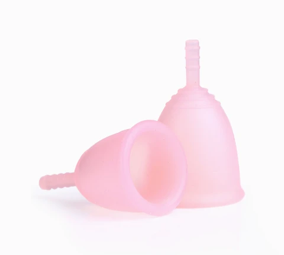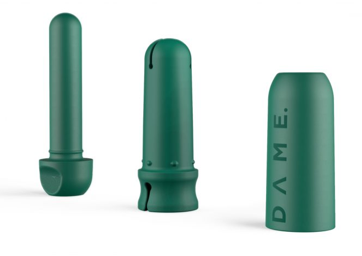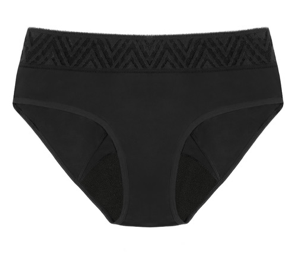The Best Alternatives to Plastic Period Products
By Paula Gonzalez Alvarez, Bethesda Green 2020-2021 Environmental Leader
Have you ever wondered what women who live in the Amazon Rainforest, or any other part of the world that does not have supermarkets, do when they are on their periods? Keep in mind that they do not have access to pads, tampons, or cups. I started to research, and I found that they feel when their periods are coming and plan accordingly. While physically it is impossible to control the period flow, Maya Melamed’s blog post explains how it works (8).
Dozens of colorful plastic tampon applicators end up in a settling pond in Terrace, B.C. (Jude Haydock)
Plastic pads and tampons are not a necessity, yet in 2018, 5.8 billion tampons were bought. In a woman’s lifetime, they usually use between 5 and 15 thousand pads (3). On average, that means women dispose of 125 to 150 kilograms of tampons, pads, and applicators in their lifetime, all of which are mainly made out of plastic (10). But do not worry because even if you are not aware of your period enough to control it, there are many great alternatives out there that you can use to start being part of the solution instead of contributing to the plastic pollution problem.
First, there is the menstrual cup. Instead of wasting single-use plastics that generate more than 200,000 tons of waste per year, menstrual cups can last up to ten years with proper care (10). I recently started using a cup and I’ve been using it for about six months now. I find them a lot better than tampons. Not only because they contaminate less, but they are also a lot cheaper than tampons and pads. On average, women spend $4.85 on tampons and pads each time they get their period, which over ten years adds up to about $582.27, while a cup only costs you about $30 (or about $50 if you also want to buy a sterilizer for the cup) for the ten years (2). They also last longer. While you should never wear a single tampon for more than eight hours at a time, you can wear a cup for up to twelve hours at a time (7). While cups are a bit more uncomfortable and messier to put in, they feel pretty much the same during the day (2). But if you do not want to try a cup, there are still plenty of options available.
An option that could be more pleasant as it might seem more familiar is to get organic and biodegradable alternatives to pads and tampons. While this option is probably the most expensive one, it is both environmentally friendly and comfortable. There are a variety of brands that provide plastic-free supplies, including Lola, which can even ship what you need to your house. Their products are all made with 100% organic cotton and while they have some plastic applicator tampons, they also have cardboard ones. Another amazing company is The Organic Project. They also have 100% organic cotton period products that are eco-friendly, and they donate their products to girls in need. As I previously mentioned, this option is more expensive and costs about $10.63 each period (1).
If you do not want to use a cup or pay that much for your period products, do not worry because there are also reusable tampon applicators and period panties. Reusable tampon applicators are very simple to use. You just need to put the cotton tampon into the applicator, take off the cap, and push in the tampon as you would with a normal plastic applicator. After being used, you just need to rinse it, dry it, and put the cap back on. I have never tried it, but Kyli Rodriguez-Cayro’s blog post explains that it is just as comfortable as any other plastic tampon and you can use it for multiple sizes of tampons. Thinx and DAME are both brands that produce FDA-approved tampon applicators (4). Thinx’s costs $60 and DAME’s costs $26 and they last you a lifetime! With the tampon applicators, you still need to buy non-applicator cotton tampons. The cost of tampons (using the average of 20 tampons used per period) for a single period would still be under what plastic tampons cost at just $3.24.
Period panties are more similar to pads. They are completely reusable and environmentally friendly while holding up to four tampons worth of menstrual fluid. They come in all shapes and sizes and have a highly absorbent fabric that feels comfortable for women with any type of flow (12).
All these amazing options are smarter both economically and environmentally. I hope you consider trying out something new because there are solutions for every preference out there. Remember: to be plastic-free does not mean you need to be uncomfortable! You just need to find the option that fits you best.
Sources
(1) Amazon.com: o.b. Original Non-Applicator Tampons, Regular, Super, & Super Plus Absorbancies, Multi Pack of 40 Tampons: Health & Personal Care. (2021). Amazon.com. https://www.amazon.com/b-Applicator-Digital-Tampons-Multi-Pack/dp/B00NJNJ6WI
(2) Annamarya Scaccia. (2017, November 14). Everything You Need to Know About Using Menstrual Cups. Healthline; Healthline Media. https://www.healthline.com/health/womens-health/menstrual-cup#:~:text=Cup%20aftercare&text=Your%20cup%20should%20be%20emptied,10%20years%20with%20proper%20care.
(3) How tampons and pads became so unsustainable. (2019, September 6). Environment. https://www.nationalgeographic.com/environment/2019/09/how-tampons-pads-became-unsustainable-story-of-plastic/
(4) Kyli Rodriguez-Cayro. (2019, March 6). I Tried DAME’s Reusable Tampon Applicator, & Here’s How It Worked. Bustle; Bustle. https://www.bustle.com/p/i-tried-dames-reusable-tampon-applicator-heres-how-it-worked-16814193
(5) Lauriello, S. (2019, January 25). The First Reusable Tampon Applicator Is Now for Sale—Here’s What an Ob-Gyn Thinks. Health.com; Health.com. https://www.health.com/condition/menstruation/thinx-reusable-tampon-applicator#:~:text=The%20reusable%20applicator%20doesn’t,insert%20as%20you%20always%20do.
(6) Melamed, M. (2018, January 7). The Most Fantastically Empowering Thing You Will Ever Learn About Your Period. Medium; Athena Talks. https://medium.com/athena-talks/the-most-fantastically-empowering-thing-you-will-ever-learn-about-your-period-8df85e4b775f
(7) Office of the Commissioner. (2020). The Facts on Tampons—and How to Use Them Safely. U.S. Food and Drug Administration. https://www.fda.gov/consumers/consumer-updates/facts-tampons-and-how-use-them-safely#:~:text=Never%20wear%20a%20single%20tampon,fever%20or%20other%20unusual%20symptoms.
(8) Period Myths Busted. (2021). Young Scot. https://young.scot/get-informed/national/period-myths-busted#:~:text=MYTH%3A%20You%20can%20hold%20in,sphincters%20so%20cannot%20be%20controlled.
(9) Period Products, Pads, Wipes, Liners, Tampons & More | LOLA. (2021). LOLA. https://www.mylola.com/collections/periods?gclid=Cj0KCQiA962BBhCzARIsAIpWEL3k8rUqT7gtDn08-oNRV_og5zz3JCjsw-UxD9X_2ce8VlHhyeoPkhYaAt7qEALw_wcB
(10) Powerful Environmental Reasons To Switch To A Menstrual Cup. (2020, September 22). OrganiCup. https://www.organicup.com/environmental-reasons-to-switch/
(11) TOP 100% Organic Cotton Period Products | Organic Tampons & Pads. (2021). TOP the Organic Project. https://toporganicproject.com/
(12) WATCH — Period products are bad for the environment so I tried this underwear | CBC Kids News. Kids News. https://www.cbc.ca/kidsnews/post/watch-period-products-are-bad-for-the-environment-so-i-tried-this-underwear
About the author:
 Paula Gonzalez Alvarez, Bethesda Green 2020-2021 Environmental Leader
Paula Gonzalez Alvarez, Bethesda Green 2020-2021 Environmental Leader
Paula Gonzalez Alvarez is a Senior at Walt Whitman High School and an aspiring engineer. She believes learning about green living and environmental conservation will help her create more sustainable projects in the future.









